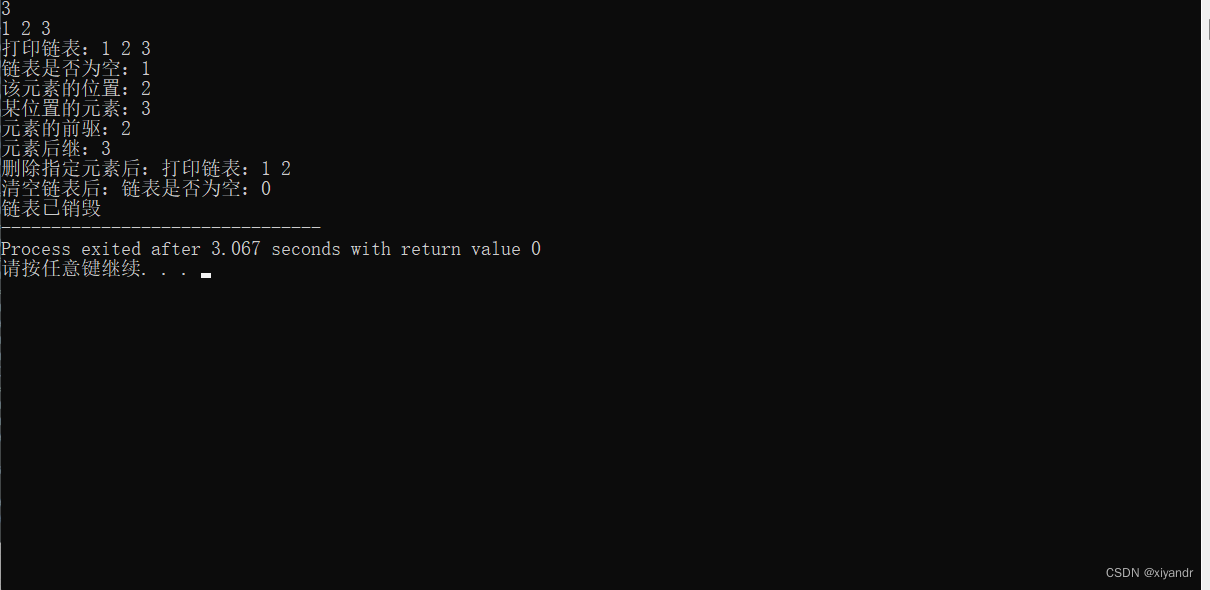先上代码:双向链表的基本操作
#include <stdio.h>
#include <string.h>
#include <stdlib.h>
#define overflow 1
typedef struct node_{
int data;
struct node_ *next;
struct node_ *precursor;
}Node,*node;
void initList(node &l);
void insertNode(node &l,int n);
void clearList(node &l);
void desList(node &l);
bool listEmpty(node &l);
int getElement(node &l,int i);
int locateElement(node &l,int e);
int priorElement(node &l,int e);
int nextElement(node &l,int e);
void deleteNode(node &l,int e);
void test();
//建立链表
void initList(node &l){
l=(node)malloc(sizeof(Node));
l->next=NULL;
l->precursor=NULL;
if (!l){
exit(overflow);
}
}
//插入元素
void insertElement(node &l,int n,int g){
node p,q;
p=l;
for (int i = 0; i < g; i ++) {
p = p->next;
if (p == NULL) {
printf("The position %d is beyond the scope of the list.", g);
return;
}
}
q = (node)malloc(sizeof(Node));
q->data = g;
q->next = p->next;
p->next = q;
q->precursor=p;
q->next->precursor=q;
}
//尾插法
void insertNode(node &l,int n){
if(n<0){
printf("输入的n不合法\n");
exit(overflow);
}
node last=NULL;
last=l;
for (int i=0;i<n;i++){
node p=(node)malloc(sizeof(Node));
scanf("%d",&p->data);
p->next=NULL;
p->precursor=NULL;
last->next=p;
p->precursor=last;
last=p;
}
}
//打印链表
void printList(node &l)
{
if (!l)
{
printf("链表不存在");
exit(overflow);
}
printf("打印链表:");
for (node p=l->next;p;p=p->next)
{
printf("%d ",p->data);
}
printf("\n");
}
//清空链表
void clearList(node &l)
{
node p=l->next;
node q=p;
while(p){
q=p->next;
free(p);
p=NULL;
p=q;
}
l->next=NULL;
}
//销毁链表
void desList(node &l){
node p=l;
node q=p;
while(p->next){
q=p->next;
free(p);
p=NULL;
p->next=q->next;
}
l=NULL;
printf("链表已销毁");}
//检查链表是否为空
bool listEmpty(node &l)
{
if (l->next)
{
return true;
}
else
{
return false;
}
}
//返回链表第i个的值
int getElement(node &l,int i){
if (i<=0 || l->next==NULL){
printf("链表为空或i的值不合法");
exit(overflow);
}
node p=l;
for (int q=0;q<i;q++)
{
p=p->next;
}
return p->data;
}
//返回与e值相同的元素位置
int locateElement(node &l,int e){
int i=0;
for (node p=l->next;p;p=p->next)
{
i++;
if (p->data==e){
return i;
}
}
return 0;
}
//返回指定元素的前驱
int priorElement(node &l,int e){
for (node p=l->next;p;p=p->next)
{
if (p->data==e){
return p->precursor->data;
}
}
return 0;
}
//返回指定元素的后继
int nextElement(node &l,int e)
{
for (node p=l->next;p->next;p=p->next)
{
if (p->data==e){
return p->next->data;
}
}
return 0;
}
//删除指定的结点
void deleteNode(node &l,int e){
node p=l;
while(p->next)
{
if (p->next->data==e){
node q=p->next;
p->next=p->next->next;
free(q);
q=NULL;
}
else
p=p->next;
}
}
void test(){
node l;
initList(l);
int n;
scanf("%d",&n);
insertNode(l,n);
printList(l);
bool r=listEmpty(l);
printf("链表是否为空:%d\n",r);
int e;
e=locateElement(l, 2);
printf("该元素的位置:%d\n",e);
e=getElement(l,3);
printf("某位置的元素:%d\n",e);
e=priorElement(l,e);
printf("元素的前驱:%d\n",e);
e=nextElement(l,e);
printf("元素后继:%d\n",e);
deleteNode(l,e);
printf("删除指定元素后:");
printList(l);
clearList(l);
r=listEmpty(l);
printf("清空链表后:");
printf("链表是否为空:%d\n",r);
desList(l);
}
int main(void)
{
test();
return 0;
}
运行结果:

总结:
双向链表的相关操作还是比较简单。关键收获在于:这次再写双向链表的过程中依然出现了之前经常出现的问题---关于内存方面,这次看了好一些文章看完总算有种豁然开朗的感觉(以前内存方面确实学得太差了)
附上几篇好文章:C与C++关于*与&的传参解析 (baidu.com)





















 941
941











 被折叠的 条评论
为什么被折叠?
被折叠的 条评论
为什么被折叠?








